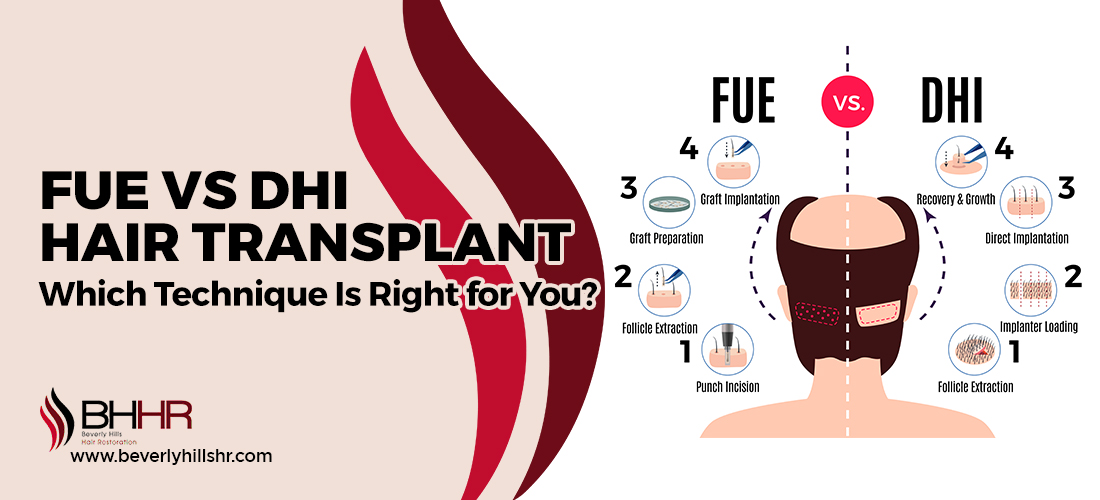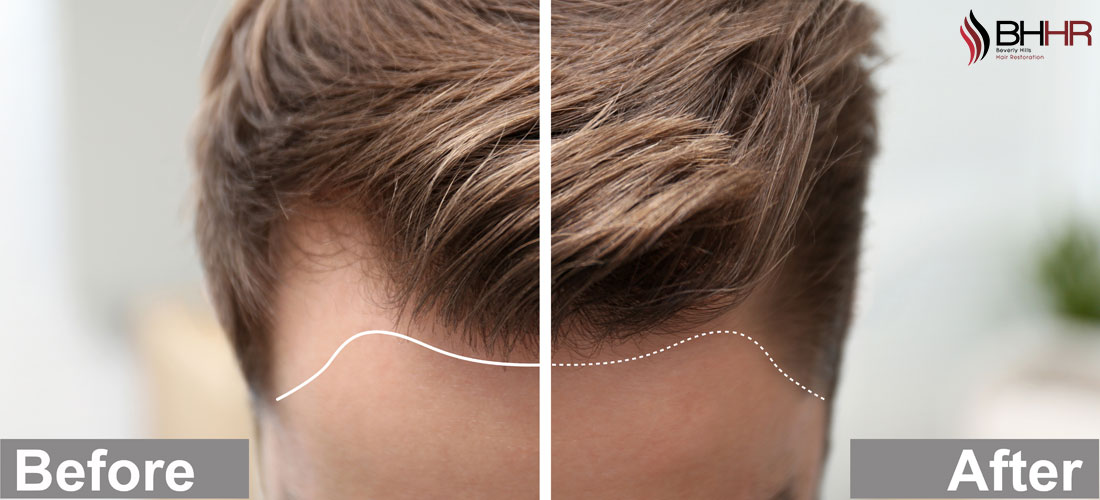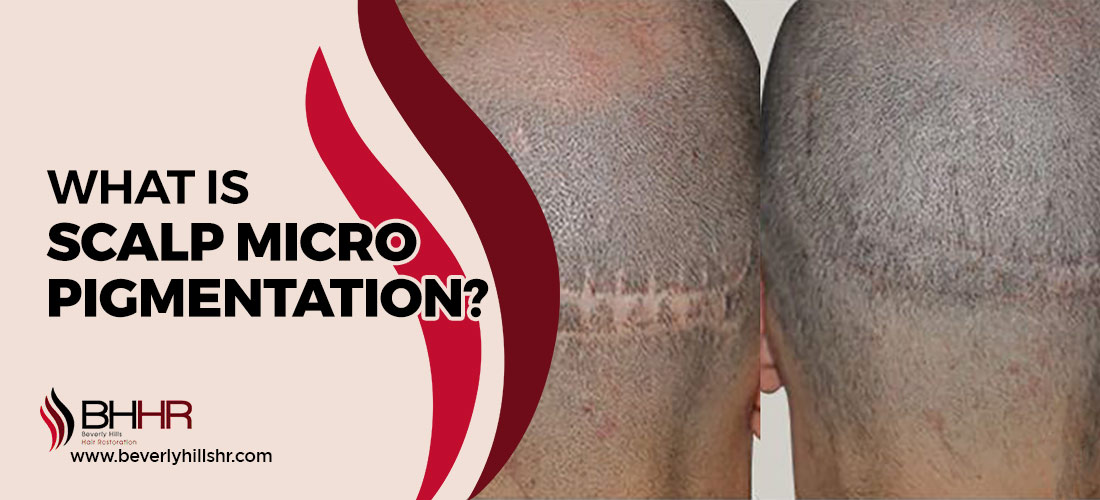FUE vs DHI Hair Transplant: Which Technique Is Right for You?
Home / Hair Transplant / FUE vs DHI Hair Transplant: Which Technique Is Right for You?
Updated On : October 24, 2025 | Category : Hair Transplant | Author: Beverly Hills Hair Restoration Team

Hair loss can deeply affect your confidence and self-image, but modern hair restoration techniques make it easier than ever to achieve a fuller, natural-looking head of hair. Among the most popular methods are FUE (Follicular Unit Extraction) and DHI (Direct Hair Implantation) — both known for producing natural, long-lasting results with minimal recovery time. This guide explores the key differences between FUE vs DHI hair transplant procedures to help you make an informed decision about which is best suited for your needs. At Beverly Hills Hair Restoration (BHHR), we specialise in Advanced hair transplant techniques that prioritise precision, comfort, and exceptional outcomes for patients seeking natural and confident hair restoration results.
Understanding FUE Hair Transplant
Nowadays, FUE (Follicular Unit Extraction) is one of the most widely performed hair transplant methods in the world — trusted for its precision, natural results, and quick recovery.
What Is a FUE Hair Transplant?
The Follicular Unit Extraction (FUE) method involves the separate removal of hair follicles from the donor site (usually the back of the head) and their implantation into balding or thinning areas with great care.
This minimally invasive approach leaves tiny, almost invisible scars, allowing for quick recovery and natural-looking results. FUE hair transplant has become the foundation for most modern hair restoration methodsI.
How FUE Is Performed
- Donor Extraction: Healthy follicles are extracted one by one using a micro-punch tool.
- Graft Preparation: The follicles are sorted and prepared under a microscope for implantation.
- Implantation: Small incisions are made in the recipient area, and grafts are carefully placed at natural angles.
- Recovery: Patients are normally back to normal within a few days, with noticeable new hair growth visible in a few months.
FUE is a safe, efficient, and suitable option for most individuals seeking natural hair restoration with minimal downtime.
Understanding DHI Hair Transplant
While FUE remains the foundation for most modern hair restoration procedures, DHI (Direct Hair Implantation) takes the process one step further with enhanced precision and control.
What Is a DHI Hair Transplant?
Direct Hair Implantation (DHI) is a modified form of FUE that utilises a specialised implantation pen to insert follicles directly into the scalp, eliminating the need for incisions beforehand.
This allows for greater control over hair direction, angle, and density, making it ideal for smaller areas such as the hairline or temples.
Advantages:
- Reduced handling of grafts (less trauma and higher survival potential)
- No need for pre-made incisions
- Highly precise placement
Limitations:
- Longer procedure time
- Higher cost
- Typically best for smaller treatment zones rather than full scalp coverage
Comparing DHI vs FUE Hair Transplant Techniques
|
Feature |
FUE |
DHI |
|
Technique |
Extracts and then implants grafts manually |
Extracts and implants grafts directly with an implanter pen |
|
Incisions |
Tiny recipient sites created before placement |
No pre-made incisions needed |
|
Speed |
Faster for larger coverage areas |
Slower, more detailed process |
|
Graft Survival Rate |
Very high (90–95%) |
Similarly, depends on the surgeon skill |
|
Cost |
Generally lower |
Usually higher |
|
Best For |
Larger areas, general thinning |
Hairline refinement, small areas |
Why Beverly Hills Hair Restoration Specialises in Advanced FUE
At Beverly Hills Hair Restoration, we’ve refined traditional FUE into an Advanced FUE method that delivers superior precision, graft survival, and comfort. This process, referred to as Smart FUE, inject plasma therapy? to enhance healing and improve results.
This innovation combines proven FUE reliability with modern regenerative science, ensuring your new hair looks and feels completely natural.
Why BHHR Recommends Smart FUE Over DHI
While both FUE and DHI are effective, BHHR recommends Smart FUE for its versatility and efficiency. Here’s why:
- Works for all hair types and coverage needs
- Faster sessions for broader restoration
- Comparable or higher graft survival rates using plasma-assisted techniques
By integrating advanced technology and surgical precision, BHHR’s FUE method achieves natural density, minimal downtime, and lasting results — making it the gold standard for hair restoration.
Conclusion: FUE vs DHI Hair Transplant — Which Is Best?
Both FUE (Follicular Unit Extraction) and DHI (Direct Hair Implantation) are advanced techniques shaping the future of modern hair restoration. However, at Beverly Hills Hair Restoration (BHHR), our plasma-enhanced Advanced FUE method stands out for its superior precision, comfort, and natural-looking outcomes. This innovative approach enhances graft survival and promotes faster healing, ensuring long-lasting, natural results tailored to each patient’s needs. If you’re comparing DHI vs FUE hair transplant options, our skilled specialists will guide you through every step, helping you choose the method that best aligns with your goals.
Not sure which option suits you? Call now at 310.289.0901 to book a free consultation with BHHR today to receive a personalised assessment and expert recommendation for your hair restoration journey.
FAQs About DHI vs FUE Hair Transplant
Is DHI more expensive than FUE?
Yes. DHI is typically more expensive because it requires specialised tools (the implanter pen) and takes longer to perform. FUE, on the other hand, offers broader coverage at a more affordable price — making it the preferred choice for patients seeking value, speed, and consistent results.
How long does recovery take after FUE and DHI?
Both are minimally invasive, so recovery is often rapid. Most can resume normal activities in 3–5 days. There can be some minor redness or scabbing, but it usually subsides within a week. Complete hair growth starts at 3–4 months after the procedure, with visible results at 9–12 months.
Which technique is better for large areas of baldness?
FUE is usually more appropriate for areas of greater coverage, like the crown or top of the head, as it's quicker and more efficient for greater graft counts. DHI is better for smaller or detailed areas like shaping a hairline or adding onto thinning patches.
Does DHI have a higher graft survival rate than FUE?
When performed correctly, both FUE and DHI have similar graft survival rates, ranging from 90% to 95%. The surgeon’s technique, graft handling, and aftercare matter more than the specific method. At Beverly Hills Hair Restoration, plasma-assisted FUE (Smart FUE) further enhances graft survival and healing outcomes.
Are there visible scars after FUE or DHI?
No real scarring can be seen with either procedure. FUE produces small, point-like marks that disappear eventually and are almost imperceptible even with short hair. DHI is also minimally traumatic and provides a sleek, natural-feeling scalp upon recovery.



